
|   |

|   |
Yugaantar celebrates Kumudini Lakhia's epoch-making contribution to Kathak - Dr. S.D. Desai e-mail: sureshmrudula@gmail.com Photos courtesy: Kadamb February 15, 2020 Yugaantar is when a new epoch has set in. 2020 is a vantage point from which Kathak with Kumudini Lakhia's distinctive contribution to it can be viewed. Two significant events will take place during the year. She will turn 90 and the Kadamb Centre for Dance and Music will complete 60 years. Kathak was a male preserve when she learnt it and started dancing in the country and abroad. Classical dance was looked down upon in Gujarat when she made a modest beginning of teaching it after her marriage with Rajnikant Lakhia, an educated and cultured businessman. Kathak was also meant primarily for solo performances till then. The Kathak guru, invariably a man, used to be strict and tradition-bound. He would not encourage questions, many of us have heard Kumiben say from time to time. The space in which it was danced on stage was literally limited, so also was it in terms of its themes. Krishna tales, handed down through its traditional kavit, with his love games with gopis and Radha, certainly enchanting in their own way, used to get depicted through the form. The Kathak that strode out of Kadamb during three scores of its existence in Ahmedabad with its dancers - chiefly beautiful, ebullient and educated modern girls - is different.  The two-segment presentation that was made as part of a well-designed event Yugaantar at the Tagore Memorial Hall on February 4 with the elite of the city in the packed auditorium offered the vantage view. Among other features, it is Kumudini Lakhia's choreographies that bear her signature. Luxuriant visible clusters within clusters of images, exhilarating to look at in their colour, taste and exuberance of joy, spread out like life itself on the length and breadth of the stage. Day One began with reminiscences of Kumiben's choreographies etched out in time, etched out though dance is a temporal art. Dhabkar and Darbari Tarana in particular evoke nostalgia for me because I was privileged to watch the original in Bhopal as part of 'Kathak Kaumudini' in1989. 'Exquisite in form and lyrical in their appeal, they can be viewed again,' I had observed. The damsels attired in subtle gradations of colour, 'dancing with poise and grace were at their beautiful best' to Atul Desai's path-breaking music stimulating Kathak steps. The music for Dhabkar and Tarana was, like their choreography, the same for the emerging group of Kadamb dancers, petite and elegant (Manasi, Kuhuk, Nirzari, Maheera, Anar, Nao, Vaishnavi in one and with Mitali, Rohit, Mukesh, led by Rupanshi Kashyap, added to them in the other), in their white attire illumined by Gyan Dev Singh's lights contributing to the mood. Created with Kumiben and Atul bhai's complementary insights, it commemorates a breakthrough in Kathak choreography. With the confidence they sourced from their iconic guru, the up-and-coming dancers draw designs in space with their movement - horizontal, vertical, linear, wavelike in impeccably finished lines in one and display their celebratory mood in the other. The stage is their world. There was only one gallant boy in the group that performed in Bhopal (1990). Now there are many boys, coming from different well-known Kathak centres. Between Dhabkar and Tarana, five energetic young male dancers (Rohit, Mukesh, Abhishek, Mohit, Sanjeet) participated in a lively Padhant, an excerpt from a 2018 production. Besides demonstrating admirable flights, chakkars, strides and mridang-vaadan, they had a samvaad and a lively good-humoured bahas between them. Their kanduk-kreeda was delightful with timed playful and rhythmic action.  Aditi Mangaldas Aditi Mangaldas, one of Kumiben's earliest disciples at Kadamb emerged in the second half of the program as one who with the Kathak vocabulary she has learnt takes her thematic expression to the level of poetry with an appeal to the aesthetic sense of the modern viewer. Combining reason and emotion as also technique and skill in Immersed she has her physical existence melt into the portrayal of a human being gifted with a rare sensibility to see herself as part of the universe in which Krishna permeates as a fragrance. She demonstrated to dancers backstage and in the auditorium, irrespective of the form they pursued, the peak it is possible to scale through the medium. Krishna is worshipped in India and across as a unique divine being. Aditi perceives and portrays Krishna as an omnipresent formless entity. It can be recognized, smelt and heard, can be enshrined within and have a dialogue with. She has live music from competent Drishtikon musicians all through in her three-part breathtaking presentation. She begins marveling at Krishna's myriad names. 'Whose imagination?' she seems to ask. She thinks of Saamvare Chhaila as the very breath of life in the second part. She sees him in all that is mobile like the deer, in the flights of birds and in the fish exploring the depths. Her intricately expressive mudras, quicksilver facial expression and graceful agility were a delight to the eyes as much as their connotation Jit dekhu-n tit Krishna ('Krishna wherever I look') was to the soul. This suggested his ubiquitous presence more powerfully perhaps - and rightly so - than the larger than life breathtaking projection of the wonderstruck nayika on the screen in three images. This is the right place to mention eminent lighting designer Gyan Dev's contribution, integral to the production.  Dr. S.D. Desai, a professor of English, has been a Performing Arts Critic for many years. Among the dance journals he has contributed to are Narthaki, Sruti, Nartanam and Attendance. His books have been published by Gujarat Sahitya Academy, Oxford University Press and Rupa. After 30 years with a national English daily, he is now a freelance art writer. |